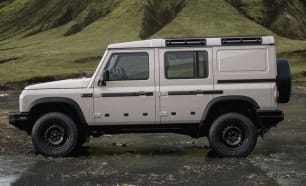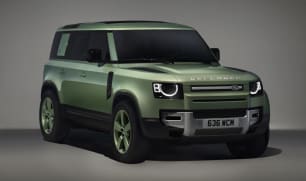The Defender’s 75th anniversary touches are all cosmetic which is fine because, as is, this Landie is surprisingly impressive on-road, and supremely effective off-road.
This 110 variant is 5018mm long (including the rear-mounted spare tyre), 2008mm wide and 1972mm high with a 3022mm-long wheelbase.
It has a turning circle of 12.8m and a kerb weight is 2297kg.
So, it’s not a small vehicle, but it never feels unwieldy to drive and it even manages to consistently feel lively and dynamic.
The Defender has a real planted feel on the road; it’s composed and very comfortable, no matter how hard you drive it.
It’s also quiet. Very quiet, and oh-so-refined, with noise, vibration and harshness levels having been subdued to almost nothing.
The new Defender’s cabin is a pleasantly cocooned space, in which you feel insulated from the world around you. There is a bit of wind rush around the Defender’s wing mirrors, but nothing atrocious.
Throttle response is crisp, and the 3.0-litre petrol’s 294kW and 550Nm are readily available for a punchy standing-start, or to safely and smoothly overtake another vehicle on the highway – or during low-range 4WDing, but more about that later*.
(* Okay, if you can’t wait, skip ahead to read about the off-road section of this test.)
The eight-speed automatic transmission is very cluey – it’s smarter than you and me – but I found the shifter’s size (stubby) and position (just under the multimedia system’s touchscreen) a bit annoying to work with as I preferred to use Sport/manual mode, sometimes requiring quick shifts up or down.
Road-holding is tremendous, especially considering previous Defenders were about as composed as wonky tractors, and comfort levels are exceptional for something that was once considered a form of punishment to travel in.
Our test vehicle was on 20-inch rims and 255/60 R20 Goodyear Wrangler ‘all-terrain adventure’ tyres and those are perfectly fine for driving on blacktop.
However, they became quickly gummed up with clay and mud during our 4WD testing phase, but more about that soon.
So, how does it perform off-road? Very well, thank you very much. It does what older Defenders can do – and more. And it does it all with supreme levels of comfort and composure – something that can’t be said of older Defenders.
In terms of off-road measures, the Defender has a claimed 228mm-291mm of ground clearance (courtesy of height-adjustable air suspension) and a wading depth of 900mm (again, with the benefit of the air suspension).
If the Defender’s under-carriage hits dirt, the air suspension automatically applies an emergency 75mm of extra height.
This Defender has approach, ramp (breakover) and departure angles of 38 degrees, 28 degrees, and 40 degrees, respectively.
So, it well and truly ticks all of those boxes.
On the dirt-track drive to our 4WD testing and proving ground the Defender demonstrated, as it has before, that it’s able to master and make bearable pretty much any road or track surface, no matter what sort of terrible condition that terrain is in.
This Landie was always stable and planted on the track, with plenty of the credit for that going to a robust monocoque chassis, as well as a multi-link set-up and fully independent air suspension, which as a combination works supremely well to smooth out surface imperfections at all speeds.
Ride and handling at speed through deep-rutted and potholed sections of dirt road was impressively smooth and composed.
With the air suspension raised to off-road height and tyre pressures dropped to 26 psi, we were ready to put the Defender through its paces.
For those of you who haven’t seen any of my videos or read any of my yarns, our testing site offers more than enough of a challenge to push any standard 4WD to the limits of its reasonable use. I’ve even seen modified vehicles struggle on some of our set-piece challenges.
The terrain here is a mix of steep rocky hill-climbs, slippery descents, mud-holes and water-crossings and, depending on the weather, it can either be seriously challenging or pretty bloody dangerous.
No need for any concern though because the Defender did everything asked of it – and did it all with relaxed ease. I’ve driven an all-conquering 90 at this test site before and the 110 this time was just as impressive.
Steering has a light but precise feel about it at low speeds and that's crucial for such a big vehicle during low-range 4WDing, especially when picking your right line on challenges or manoeuvring along tight, twisted tracks.
There’s plenty of low-down torque from the petrol engine and in low-range that’s evenly applied.
The Pivi touchscreen system is the new Defender’s command centre and, using it, you’re able to cycle through the terrain response programs, you can set driving modes, and essentially operate everything.
It's generally easy enough to use, but it is a bit tricky to operate on the move – and that’s one of the few niggles I have about this Defender.
The terrain response system, which enables the driver to dial through driving modes, including Mud and Ruts, and Rock Crawl is a clever set-up and would certainly feel out of place in an old-school Defender.
You can calibrate the system’s responses – acceleration, traction sensitivity, and diff control – to suit your driving style and the terrain you’re traversing.
The tread of the Defender’s Goodyear Wrangler all-terrain tyres, as mentioned earlier, swiftly became gummed up with sloppy mud and we lost a fair bit in terms of reliable traction from that rubber on the rock surfaces we moved to straight after driving through a series of shallow mud-holes.
Wheel travel is decent with the Defender able to get useable flex out of that multi-link set-up and air suspension combo.
Another of my very few gripes about the Defender is the fact that while all of the off-road-focussed driver-assist tech, especially terrain response, is so seamlessly effective – it’s almost too good for its own good.
As the driver I almost feel removed from the experience of tackling the terrain I’m on.
Driving this doesn't feel like such a visceral experience as it does in the Defenders of old, or even as hands-on as it does when driving off-road in rebooted old-school 4WDs, such as the Suzuki Jimny, or the Jeep Wrangler Rubicon.
The new Defender is very capable, and comfortably so, but it feels a little bit too clinical and calculated in its execution.
In terms of its potential as a towing platform, the Defender has a claimed maximum unbraked trailer capacity of 750kg and a maximum braked towing capacity of 3500kg.
It has a maximum roof load of 300kg. GVM (gross vehicle mass) is 3165kg and GCM (gross combined mass) is 6665kg.

